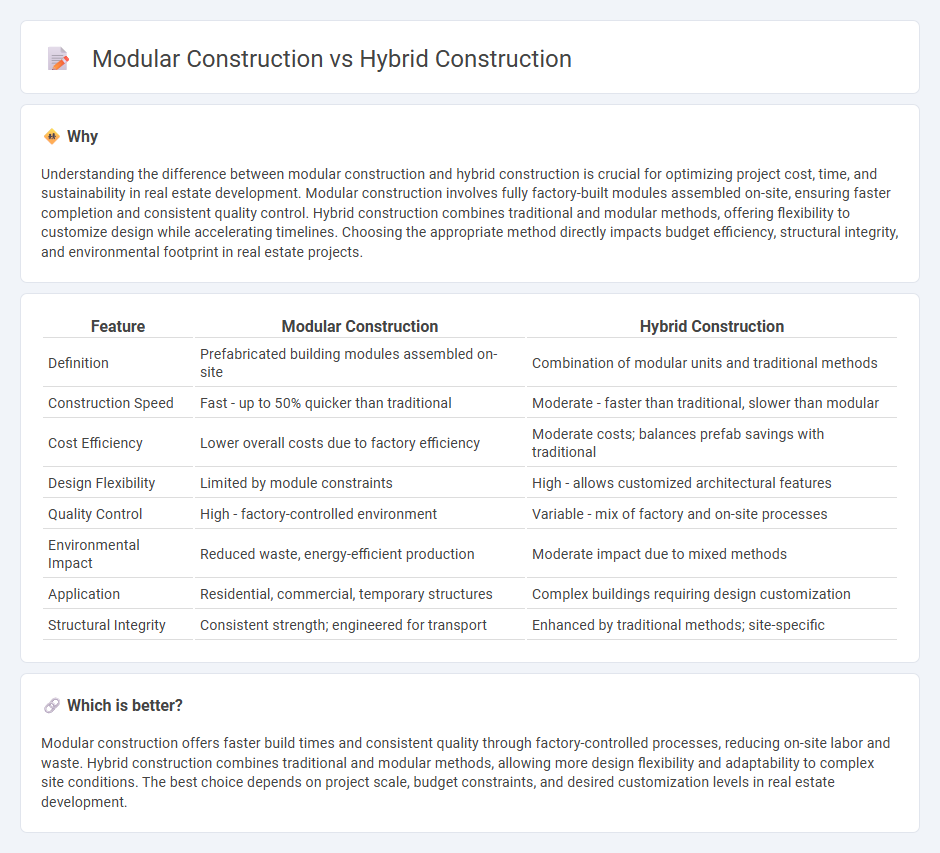
Modular construction offers the advantage of factory-built precision and faster onsite assembly, reducing labor costs and project timelines. Hybrid construction combines traditional building methods with modular components, enhancing design flexibility while maintaining efficiency and quality control. Explore the benefits and applications of these innovative real estate building techniques to determine the best fit for your project.
Why it is important
Understanding the difference between modular construction and hybrid construction is crucial for optimizing project cost, time, and sustainability in real estate development. Modular construction involves fully factory-built modules assembled on-site, ensuring faster completion and consistent quality control. Hybrid construction combines traditional and modular methods, offering flexibility to customize design while accelerating timelines. Choosing the appropriate method directly impacts budget efficiency, structural integrity, and environmental footprint in real estate projects.
Comparison Table
| Feature | Modular Construction | Hybrid Construction |
|---|---|---|
| Definition | Prefabricated building modules assembled on-site | Combination of modular units and traditional methods |
| Construction Speed | Fast - up to 50% quicker than traditional | Moderate - faster than traditional, slower than modular |
| Cost Efficiency | Lower overall costs due to factory efficiency | Moderate costs; balances prefab savings with traditional |
| Design Flexibility | Limited by module constraints | High - allows customized architectural features |
| Quality Control | High - factory-controlled environment | Variable - mix of factory and on-site processes |
| Environmental Impact | Reduced waste, energy-efficient production | Moderate impact due to mixed methods |
| Application | Residential, commercial, temporary structures | Complex buildings requiring design customization |
| Structural Integrity | Consistent strength; engineered for transport | Enhanced by traditional methods; site-specific |
Which is better?
Modular construction offers faster build times and consistent quality through factory-controlled processes, reducing on-site labor and waste. Hybrid construction combines traditional and modular methods, allowing more design flexibility and adaptability to complex site conditions. The best choice depends on project scale, budget constraints, and desired customization levels in real estate development.
Connection
Modular construction and hybrid construction are connected through their shared emphasis on combining prefabricated components with traditional building methods to enhance efficiency, reduce construction time, and lower costs in real estate development. Both approaches utilize factory-built modules alongside onsite assembly, enabling flexible design and improved quality control. This integration supports sustainable building practices and meets increasing demand for rapid urbanization and affordable housing solutions.
Key Terms
On-site assembly
Hybrid construction combines prefabricated modules with traditional on-site building techniques, optimizing flexibility and customization during assembly. Modular construction relies heavily on factory-built components assembled quickly on-site, improving speed and reducing disruptions. Discover how on-site assembly methods impact project timelines and cost-efficiency in hybrid versus modular approaches.
Prefabrication
Hybrid construction combines traditional building methods with modular prefabrication, enhancing flexibility and reducing on-site labor. Modular construction relies heavily on factory-made components, ensuring consistent quality and faster assembly times. Explore the benefits of prefabrication techniques and how they impact construction efficiency.
Structural systems
Hybrid construction combines traditional building techniques with prefabricated elements, enhancing structural flexibility and reducing onsite labor. Modular construction relies on fully prefabricated modules assembled onsite, offering rapid build times and consistent quality control. Explore detailed comparisons to understand which structural system suits your project needs best.
Source and External Links
From Timeless Materials to High-Tech Hybrids: A New Era - Hybrid construction integrates materials like timber, steel, and concrete for environmental efficiency and lifecycle benefits.
Hybrid-timber construction - Combines wood with steel, concrete, and glass to enhance structural performance and reduce environmental impact.
The Facts About Off-site Construction: Hybrid Systems - Hybrid construction systems use both panelized and modular methods to offer flexibility and efficiency in building design.
 dowidth.com
dowidth.com